Exercise 5.1
1. Find the complement of each of the following angles:
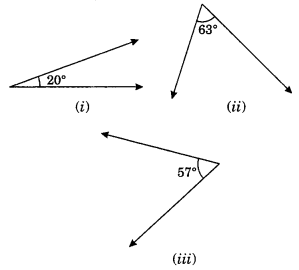
Solution:
(i) Complement of 20° = 90° – 20° = 70°
(ii) Complement of 63° = 90° – 63° = 27°
(iii) Complement of 57° = 90° – 57° = 33°
2. Find the supplement of each of the following angles:
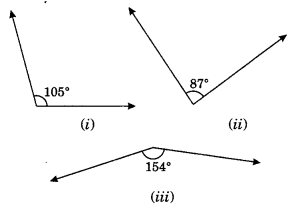
Solution:
(i) Supplement of 105° = 180° – 105° = 75°
(ii) Supplement of 87° = 180° – 87° = 93°
(iii) Supplement of 154° = 180° – 154° = 26°
3. Identify which of the following pairs of angles are complementary and which are supplementary.
(i) 65o, 115o
Solution:-
We have to find the sum of given angles to identify whether the angles are complementary or supplementary.
Then,
= 65o + 115o
= 180o
If the sum of two angle measures is 180o, then the two angles are said to be supplementary.
∴These angles are supplementary angles.
(ii) 63o, 27o
Solution:-
We have to find the sum of given angles to identify whether the angles are complementary or supplementary.
Then,
= 63o + 27o
= 90o
If the sum of two angle measures is 90o, then the two angles are said to be complementary.
∴These angles are complementary angles.
(iii) 112o, 68o
Solution:-
We have to find the sum of given angles to identify whether the angles are complementary or supplementary.
Then,
= 112o + 68o
= 180o
If the sum of two angle measures is 180o, then the two angles are said to be supplementary.
∴These angles are supplementary angles.
(iv) 130o, 50o
Solution:-
We have to find the sum of given angles to identify whether the angles are complementary or supplementary.
Then,
= 130o + 50o
= 180o
If the sum of two angle measures is 180o, then the two angles are said to be supplementary.
∴These angles are supplementary angles.
(v) 45o, 45o
Solution:-
We have to find the sum of given angles to identify whether the angles are complementary or supplementary.
Then,
= 45o + 45o
= 90o
If the sum of two angle measures is 90o, then the two angles are said to be complementary.
∴These angles are complementary angles.
(vi) 80o, 10o
Solution:-
We have to find the sum of given angles to identify whether the angles are complementary or supplementary.
Then,
= 80o + 10o
= 90o
If the sum of two angle measures is 90o, then the two angles are said to be complementary.
∴These angles are complementary angles.
4. Find the angles which is equal to its complement.
Solution:-
Let the measure of the required angle be xo.
We know that, sum of measures of complementary angle pair is 90o.
Then,
= x + x = 90o
= 2x = 90o
= x = 90/2
= x = 45o
Hence, the required angle measures is 45o.
5. Find the angles which is equal to its supplement.
Solution:-
Let the measure of the required angle be xo.
We know that, sum of measures of supplementary angle pair is 180o.
Then,
= x + x = 180o
= 2x = 180o
= x = 180/2
= x = 90o
Hence, the required angle measures is 90o.
6. In the given figure, ∠1 and ∠2 are supplementary angles. If ∠1 is decreased, what changes should take place in ∠2 so that both angles still remain supplementary.
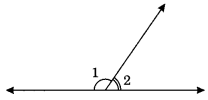
Solution:-
From the question, it is given that,
∠1 and ∠2 are supplementary angles.
If ∠1 is decreased, then ∠2 must be increased by the same value. Hence, this angle pair remains supplementary.
7. Can two angles be supplementary if both of them are:
(i). Acute?
Solution:-
No. If two angles are acute, means less than 90o, the two angles cannot be supplementary. Because, their sum will be always less than 90o.
(ii). Obtuse?
Solution:-
No. If two angles are obtuse, means more than 90o, the two angles cannot be supplementary. Because, their sum will be always more than 180o.
(iii). Right?
Solution:-
Yes. If two angles are right, means both measures 90o, then two angles can form a supplementary pair.
∴90o + 90o = 180
8. An angle is greater than 45o. Is its complementary angle greater than 45o or equal to 45o or less than 45o?
Solution:-
Let us assume the complementary angles be p and q,
We know that, sum of measures of complementary angle pair is 90o.
Then,
= p + q = 90o
It is given in the question that p > 45o
Adding q on both the sides,
= p + q > 45o + q
= 90o > 45o + q
= 90o – 45o > q
= q < 45o
Hence, its complementary angle is less than 45o.
9. In the adjoining figure:
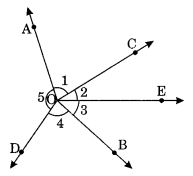
i) Is ∠1 adjacent to ∠2?
Solution:-
By observing the figure we came to conclude that,
Yes, as ∠1 and ∠2 having a common vertex i.e. O and a common arm OC.
Their non-common arms OA and OE are on both the side of common arm.
(ii) Is ∠AOC adjacent to ∠AOE?
Solution:-
By observing the figure, we came to conclude that,
No, since they are having a common vertex O and common arm OA.
But, they have no non-common arms on both the side of the common arm.
(iii) Do ∠COE and ∠EOD form a linear pair?
Solution:-
By observing the figure, we came to conclude that,
Yes, as ∠COE and ∠EOD having a common vertex i.e. O and a common arm OE.
Their non-common arms OC and OD are on both the side of common arm.
(iv) Are ∠BOD and ∠DOA supplementary?
Solution:-
By observing the figure, we came to conclude that,
Yes, as ∠BOD and ∠DOA having a common vertex i.e. O and a common arm OE.
Their non-common arms OA and OB are opposite to each other.
(v) Is ∠1 vertically opposite to ∠4?
Solution:-
Yes, ∠1 and ∠2 are formed by the intersection of two straight lines AB and CD.
(vi) What is the vertically opposite angle of ∠5?
Solution:-
∠COB is the vertically opposite angle of ∠5. Because these two angles are formed by the intersection of two straight lines AB and CD.
10. Indicate which pairs of angles are:
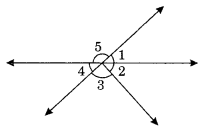
(i) Vertically opposite angles.
Solution:-
By observing the figure we can say that,
∠1 and ∠4, ∠5 and ∠2 + ∠3 are vertically opposite angles. Because these two angles are formed by the intersection of two straight lines.
(ii) Linear pairs.
Solution:-
By observing the figure we can say that,
∠1 and ∠5, ∠5 and ∠4 as these are having a common vertex and also having non common arms opposite to each other.
11. In the following figure, is ∠1 adjacent to ∠2? Give reasons.

Solution:-
∠1 and ∠2 are not adjacent angles. Because, they are not lie on the same vertex.
12. Find the values of the angles x, y, and z in each of the following:
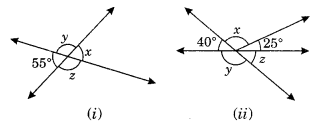
Solution:- (i)
∠x = 55o, because vertically opposite angles.
∠x + ∠y = 180o … [∵ linear pair]
= 55o + ∠y = 180o
= ∠y = 180o – 55o
= ∠y = 125o
Then, ∠y = ∠z … [∵ vertically opposite angles]
∴ ∠z = 125o
(ii)
Solution:-
∠z = 40o, because vertically opposite angles.
∠y + ∠z = 180o … [∵ linear pair]
= ∠y + 40o = 180o
= ∠y = 180o – 40o
= ∠y = 140o
Then, 40 + ∠x + 25 = 180o … [∵angles on straight line]
65 + ∠x = 180o
∠x = 180o – 65
∴ ∠x = 115o
13. Fill in the blanks:
Fill in the blanks:
(i) If two angles are complementary, then the sum of their measures is ______ .
(ii) If two angles are supplementary, then the sum of their measures is ______ .
(iii) Two angles forming a linear pair are ______ .
(iv) If two adjacent angles are supplementary, they form a ______ .
(v) If two lines intersect at a point, then the vertically opposite angles are always ______ .
(vi) If two lines intersect at a point, and if one pair of vertically opposite angles are acute angles, then the other pair of vertically opposite angles are ______ .
Solution:
(i) 90°
(ii) 180°
(iii) Supplementary
(iv) Linear pair
(v) Equal
(vi) Obtuse angle
14. In the adjoining figure, name the following pairs of angles.
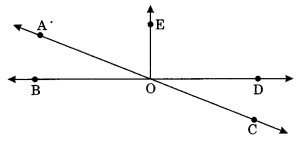
(i) Obtuse vertically opposite angles
Solution:-
∠AOD and ∠BOC are obtuse vertically opposite angles in the given figure.
(ii) Adjacent complementary angles
Solution:-
∠EOA and ∠AOB are adjacent complementary angles in the given figure.
(iii) Equal supplementary angles
Solution:-
∠EOB and EOD are the equal supplementary angles in the given figure.
(iv) Unequal supplementary angles
Solution:-
∠EOA and ∠EOC are the unequal supplementary angles in the given figure.
(v) Adjacent angles that do not form a linear pair
Solution:-
∠AOB and ∠AOE, ∠AOE and ∠EOD, ∠EOD and ∠COD are the adjacent angles that do not form a linear pair in the given figure.


